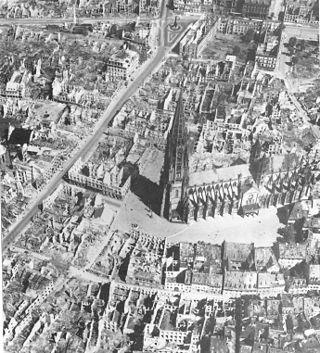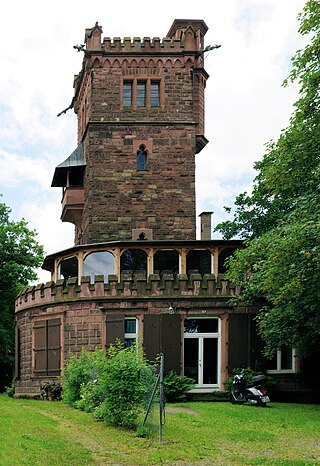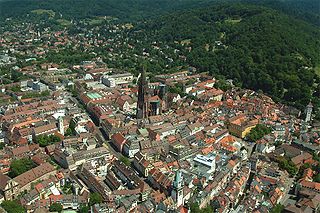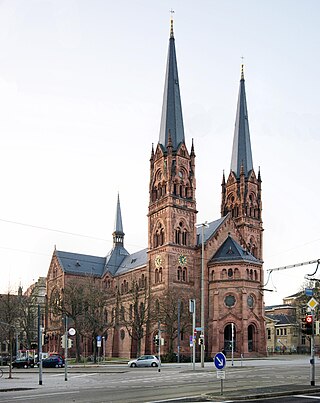
Freiburg im Breisgau is the fourth-largest city of the German state of Baden-Württemberg after Stuttgart, Mannheim and Karlsruhe. Its built-up area has a population of about 355,000 (2021), while the greater Freiburg metropolitan area ("Einzugsgebiet") has about 660,000 (2018).

Freiburg Minster is the cathedral of Freiburg im Breisgau, southwest Germany. The last duke of Zähringen had started the building around 1200 in romanesque style. The construction continued in 1230 in Gothic style. The minster was partly built on the foundations of an original church that had been there from the beginning of Freiburg, in 1120.

The Archdiocese of Freiburg im Breisgau is a Latin Church diocese of the Catholic Church in Baden-Württemberg comprising the former states of Baden and Hohenzollern. The Archdiocese of Freiburg is led by an archbishop, who also serves as the metropolitan bishop of the Upper-Rhine ecclesiastical province for the suffragan dioceses of Mainz and Rottenburg-Stuttgart. Its seat is Freiburg Minster in Freiburg im Breisgau.

Operation Tigerfish was the military code name in World War II for the air raid on Freiburg in the evening of 27 November 1944 by the Royal Air Force with about 2,800 dead.

The Kaiser-Joseph-Straße in Freiburg im Breisgau is a shopping street of about 900 meters, which runs through the center of Freiburg's historic downtown from north to south. It is one of the most expensive locations in Germany.

The Bertoldsbrunnen is a monument in the historic city of Freiburg im Breisgau. It is situated at the crossing of the Salz- and Bertoldsstraße with the Kaiser-Joseph-Straße. The fountain is one of the central locations of the city. A tram station with the same name is situated at the Bertoldsbrunnen where four of the five tramways of the Freiburger Verkehrs AG stop.

The Möslestadion is a football stadium in Freiburg im Breisgau. The stadium used to be home to the Freiburger FC. Today it is used by the second men's team and the Freiburg soccer school of the SC Freiburg. Since the 2008/09 season, the stadium has also been used for the SC Freiburg women's team.

The Siegesdenkmal in Freiburg im Breisgau is a monument to the German victory in the Franco-Prussian War in 1871. It was erected at the northern edge of the historic center of Freiburg im Breisgau next to the former Karlskaserne (barracks). After World War II it was moved 100m to the west. Today it is located on Europaplatz.

The Lorettoberg, also known as Josephsbergle in Freiburg, is a mountain ridge in the South-West of the Wiehre district in the city of Freiburg im Breisgau in Germany. The mountain, with its elevation of 384.5 meters (1,261 ft) above sea level, is wooded at its peak. It divides the district Unterwiehre-Süd and borders the Vauban district in the West. 500 meters (1,600 ft) north of the "peak" there is a high spur 348 m (1,142 ft) above sea level, next to which the eponymous Lorettokapelle is located. The name derives from Loreto, the second biggest Italian (Mary-) pilgrimage destination, after the St. Peter's Basilica in Rome. The Schloss-Café is located at the top of the mountain making the Lorettoberg a popular destination for a getaway, strolling and a local recreation area.

The Whale House is a late Gothic bourgeois house in the old town of Freiburg im Breisgau, Baden-Württemberg, Germany and is under conservation. The building is currently used by the Sparkasse Freiburg-Nördlicher Breisgau bank. It is part of a complex which, in the past, was made up of 17 separate buildings. The front wall of the house opens onto the Franziskanerstraße, whilst the rear is on the Gauchstraße, near Kartoffelmarkt square.
The Salzstraße in Freiburg im Breisgau is a significant part of the Freiburg city centre pedestrian area. It runs from Bertoldsbrunnen to Kaiser-Joseph-Straße, then eastward to Oberlinden square, where a fountain of the same name is located. It is probably the location of Freiburg's oldest houses. A stream, the Freiburg Bächle, runs along the street's northern side between the tramway tracks and the pavement.

The Colombischlössle is a manor house in the city centre of Freiburg im Breisgau where the eponymous archaeological museum is situated.
Mooswald is a district in the western part of Freiburg im Breisgau, Germany, which consists of the two districts Mooswald West (521) and Mooswald East (522). Its population is 9,223 (2020). In the North East, Mooswald borders the district of Brühl, with its airfield, the university campus of the technical faculty and the exhibition centre. Mooswald further borders the district of Landwasser in the North West, the district of Stühlinger in the East and the district of Betzenhausen with the Seepark in the South West. Mooswald is separated from Brühl by the Breisgau S-Bahn, from Landwasser by the Westrandstraße (Paduaallee/Mooswaldallee) and from Stühlinger by the railway tracks of the freight railway.

The History of the Jews in Freiburg dates back to the Late Middle Ages when, at the site of today's Wasserstraße and Weberstraße, there was reference to a ghetto. In 1328, a synagogue was located at 6 Weberstraße.

The Old City of Freiburg is part of the city and business centres of Freiburg im Breisgau and is the core of the original city. It is divided into the two districts 111 Altstadt-Mitte and 112 Altstadt-Ring. The Altstadt-Mitte district was the city's build-up area at the time of its foundation and therefore formed the old city. The district Altstadt-Ring is connected westwards to the railway line and south to the Dreisam.

The Johanneskirche is a Roman Catholic church located in Freiburg im Breisgau. It was first opened in 1899 and is currently located in the Wiehre district. Around the church, further historic buildings were built. On the western side is the presbytery of the community next to a vocational school and to the north is the Lessingschule. At the same time as the Johanneskirche was being completed, the Protestant Christians built their own church near to Johanneskirche, the Christuskirche.

The Platz der Alten Synagoge is a square in Freiburg, Germany. With a size of 130 by 130 metres, it is the second largest square in the city after Minster Square. The square is named after the old synagogue, which was destroyed during the Kristallnacht in 1938. The synagogue had been built in 1869/1870 to the southwest of today's location of the square.
Franz Anton Maichelbeck was a German organist and composer.

The old cemetery in Neuburg, a district of Freiburg im Breisgau, Germany, covers an area of 2.65 hectares. Situated on park-like grounds, the old cemetery is one of Germany's oldest cemeteries that have been abandoned and preserved as a whole. Located close to the Ludwigskirche, it is often mistaken to be part of the neighboring district Herdern. Providing tombs to an estimate of 1200 people, half of them are worthy of preservation. The booster club takes care of maintenance. The old cemetery falls under preservation order of cultural and natural monument. Moreover, it can be seen as evidence for death cult, town history and stylistic area of the 17th and 18th century. Serving not only as a place for individual and artistic tombstones of middle class people. Furthermore, the old cemetery grants an insight into the consciousness of faith during the baroque period until the time of neo-classicism.

The village Günterstal is the southernmost district of Freiburg im Breisgau. It is located in the so-called Bohrer-Tal area at the foot of the 1284 metre-high Schauinsland in the Günterstal district of the Black Forest. Due to this, Freiburg prides itself on being Germany's highest city. Günterstal has more than 2,000 inhabitants and is separated from Freiburg by a two-kilometre-wide meadow, the "Wonnhaldewiesen". The village was incorporated into Freiburg in 1890. The southern neighbouring municipality is Horben.

















